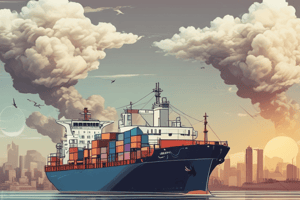Podcast
Questions and Answers
Which term refers to the commercial activity where goods or services cross national borders for profit?
Which term refers to the commercial activity where goods or services cross national borders for profit?
- Global barter
- International trade (correct)
- Domestic trade
- Local exchange
What is the primary purpose of international trade?
What is the primary purpose of international trade?
- To create competition among domestic producers
- To eliminate the need for treaties and tariffs
- To foster interconnectedness across nations (correct)
- To restrict the flow of goods and services
Which concept in international trade refers to the situation where countries focus on producing goods they are most efficient at?
Which concept in international trade refers to the situation where countries focus on producing goods they are most efficient at?
- Trade liberalization
- Trade diversification
- Trade protectionism
- Trade specialization (correct)
In international trade, what do exports primarily involve?
In international trade, what do exports primarily involve?
What is one of the key advantages of international trade mentioned in the text?
What is one of the key advantages of international trade mentioned in the text?
What is the main goal of comparative advantage in international trade?
What is the main goal of comparative advantage in international trade?
How can domestic industries be negatively impacted by international trade according to the text?
How can domestic industries be negatively impacted by international trade according to the text?
Which downside of international trade is mentioned in the text as potentially requiring protectionist policies?
Which downside of international trade is mentioned in the text as potentially requiring protectionist policies?
What is a significant reason for many countries actively participating in international trade mentioned in the text?
What is a significant reason for many countries actively participating in international trade mentioned in the text?
Why is it important for individuals to understand the fundamentals of international trade according to the text?
Why is it important for individuals to understand the fundamentals of international trade according to the text?
Flashcards are hidden until you start studying
Study Notes
Navigating Global Trade: Understanding International Trade Basics
International trade is a fundamental aspect of our global economy, fostering interconnectedness across nations by allowing businesses to buy, sell, and exchange goods and services worldwide. Let's delve into this complex yet crucial concept more deeply, exploring its core elements, benefits, and challenges for modern economies like yours and mine.
Defining International Trade
At its most basic level, international trade refers to any commercial activity wherein goods or services cross national borders with the intention of earning profit through exporting and importing. When countries engage in trade, they form a mutually beneficial relationship built on cooperation, communication, and fair agreements like treaties and tariffs.
Types of International Trade
Trade can take two primary forms—exports and imports:
- Exports occur when domestic producers deliver products or services abroad, seeking foreign demand and income.
- Imports involve bringing in foreign-made goods and services from other countries to meet local consumer preferences and needs.
Beyond these basics, there are also two widely recognized types of international trade patterns based on their impact on economic growth: trade specialization and comparative advantage. In both cases, countries aim to focus production on areas where they have unique advantages or cost efficiencies in comparison to others, thereby maximizing profits and benefiting consumers globally via increased competition and lower prices.
Benefits of International Trade
One principal reason why many countries participate actively in international trade is because it offers numerous economic benefits. Some key advantages include:
- Higher levels of output, productivity, and GDP due to expanded markets and trade opportunities.
- Improved employment rates resulting from higher demand for labor and skills within various sectors.
- Better resource allocation and utilization thanks to enhanced access to raw materials and specialized expertise from around the world.
- Enhanced innovation and technology transfer between trading partners.
Challenges of International Trade
While international trade presents significant potential gains for participating nations, certain downsides must also be considered:
- Job losses may arise if domestic industries struggle to compete against imported goods and services produced overseas.
- Economic inequality can intensify within and among nations, often leading to social unrest.
- Protectionist policies might become necessary during times of recession to shield specific industries and maintain full employment.
- Environmental concerns could grow due to unsustainable industrial practices adopted solely to increase competitiveness.
In conclusion, understanding the fundamentals of international trade is paramount for individuals who want to better comprehend the intricate workings of today’s global marketplace. By grasping the essential concepts and recognizing the advantages and disadvantages associated with such exchanges, you can make informed decisions and contribute positively to your community while engaging with the wider business arena.
Studying That Suits You
Use AI to generate personalized quizzes and flashcards to suit your learning preferences.




